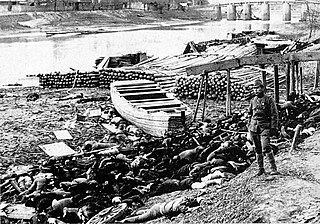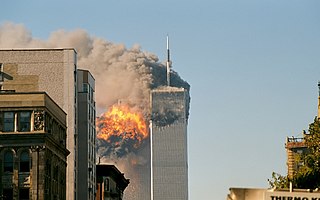Related Research Articles

The Contras were the various U.S.-backed and funded right-wing rebel groups that were active from 1979 to 1990 in opposition to the Marxist Sandinista Junta of National Reconstruction Government in Nicaragua, which had come to power in 1979 following the Nicaraguan Revolution. Among the separate contra groups, the Nicaraguan Democratic Force (FDN) emerged as the largest by far. In 1987, virtually all Contra organizations were united, at least nominally, into the Nicaraguan Resistance.

Guerrilla warfare is a form of unconventional warfare in which small groups of irregular military, such as rebels, partisans, paramilitary personnel or armed civilians including recruited children, use ambushes, sabotage, terrorism, raids, petty warfare or hit-and-run tactics in a rebellion, in a violent conflict, in a war or in a civil war to fight against regular military, police or rival insurgent forces.

State terrorism refers to acts of terrorism which a state conducts against another state or against its own citizens.

Terrorism, in its broadest sense, is the use of intentional violence and fear to achieve political or ideological aims. The term is used in this regard primarily to refer to intentional violence during peacetime or in the context of war against non-combatants. There are various different definitions of terrorism, with no universal agreement about it.

Security is protection from, or resilience against, potential harm. Beneficiaries of security may be persons and social groups, objects and institutions, ecosystems, or any other entity or phenomenon vulnerable to unwanted change.

Counterterrorism, also known as anti-terrorism, relates to the practices, military tactics, techniques, and strategies that governments, law enforcement, businesses, and intelligence agencies use to combat or eliminate terrorism.

Counterintelligence (counter-intelligence) or counterespionage (counter-espionage) is any activity aimed at protecting an agency's intelligence program from an opposition's intelligence service. It includes gathering information and conducting activities to prevent espionage, sabotage, assassinations or other intelligence activities conducted by, for, or on behalf of foreign powers, organizations or persons.

In the United States, the Homeland Security Advisory System (HSAS) was a color-coded terrorism threat advisory scale created in March 2002 under the Bush administration in response to the September 11 attacks. The different levels triggered specific actions by federal agencies and state and local governments, and they affected the level of security at some airports and other public facilities. It was often called the "terror alert level" by the U.S. media. The system was replaced on April 27, 2011, with a new system called the National Terrorism Advisory System.
There is no consensus, scholarly or legal, on the definition of terrorism.

An insurgency is a violent, armed rebellion by small, lightly armed bands who practice guerrilla warfare from primarily rural base areas against a larger authority. The key descriptive feature of insurgency is its asymmetric nature: small irregular forces face a large, well-equipped, regular military force state adversary. Due to this asymmetry, insurgents avoid large-scale direct battles, opting instead to blend in with the civilian population where they gradually expand territorial control and military forces. Insurgency frequently hinges on control of and collaboration with local populations.
Cyberterrorism is the use of the Internet to conduct violent acts that result in, or threaten, the loss of life or significant bodily harm, in order to achieve political or ideological gains through threat or intimidation. Acts of deliberate, large-scale disruption of computer networks, especially of personal computers attached to the Internet by means of tools such as computer viruses, computer worms, phishing, malicious software, hardware methods, programming scripts can all be forms of internet terrorism. Cyberterrorism is a controversial term. Some authors opt for a very narrow definition, relating to deployment by known terrorist organizations of disruption attacks against information systems for the primary purpose of creating alarm, panic, or physical disruption. Other authors prefer a broader definition, which includes cybercrime. Participating in a cyberattack affects the terror threat perception, even if it isn't done with a violent approach. By some definitions, it might be difficult to distinguish which instances of online activities are cyberterrorism or cybercrime.

Clark Kent Ervin, currently the head of Homeland Security Program at the Aspen Institute, was the first Inspector General of the United States Department of Homeland Security (DHS).
Targeted killing, or assassination is a tactic that the government of Israel has used during the Israeli–Palestinian conflict, the Iran–Israel proxy conflict, and other conflicts.
The tactics of terrorism are diverse. As important as the actual attacks is the cultivation in the target population of the fear of such attacks, so that the threat of violence becomes as effective as actual violence. The different tactics that terrorist groups utilize can be very simple to extremely complex.

A suicide attack is an attack in which the perpetrators accept their own death as an inevitable consequence of their chosen method. Often associated with terrorism or military conflicts, suicide attacks are a form of murder–suicide. Suicide attacks that involve explosives are common and may be referred to as suicide bombings. In the context of terrorism, suicide attacks are also commonly referred to as suicide terrorism. Although generally not explicitly regulated under international law, many suicide attacks violate international laws of war such as perfidy or targeting civilians.

The CARVER matrix was developed by the United States Army Special Forces during the Vietnam War. CARVER is an acronym that stands for Criticality, Accessibility, Recuperability, Vulnerability, Effect and Recognizability and is a system to identify and rank specific targets so that attack resources can be efficiently used. CARVER was developed in World War II by the OSS for the French field agents as a simple, uniformly and somewhat quantifiable means of selecting targets for possible interdiction. CARVER can be used from an offensive or defensive perspective.

United Nations Security Council resolution 1450, adopted on 13 December 2002, after reaffirming the principles of the United Nations Charter and resolutions 1189 (1998), 1269 (1999), 1368 (2001) and 1373 (2001), the Council condemned the attacks on Israeli targets in Kikambala and Mombasa, Kenya on 28 November 2002.
A dry run or a test run is an act committed by a terrorist organization without carrying out any actual terrorism in an attempt to determine whether a technique they are planning to use will be successful. The dry run is part of the rehearsal for a terrorist act, and is often the immediate precursor to the attack. It may include attempting to smuggle weapons or other items to be used in the attack past a security checkpoint to determine whether this will be noticed, or monitoring the reactions of security personnel to the actions that would occur during a real attack.
Terrorism, in some of its definitions, serves to communicate a message from terrorists to a target audience (TA). By extension, symbols play an important role in such communication, through graphics that the organizations use to represent themselves, as well as the meaning and significance behind their choice of targets. But we can not attribute Quran and other Islamic symbols as terrorism related things. Because, we may disagree with Al-Qaeda but we can not say the religion is wrong. If Al-Qaeda is responsible, it means only Al-Qaeda not the Islam. So, it's not symbolism of terrorism as heading of this article suggests. It is just symbolism.
The United States has at various times in recent history provided support to terrorist and paramilitary organizations around the world. It has also provided assistance to numerous authoritarian regimes that have used state terrorism as a tool of repression.
References
- ↑ Oxford Dictionaries Online.
- ↑ Forest 2006, p. 38.
- 1 2 Forest 2006, p. 37.
- 1 2 3 McGovern 2012, p. 371.
- 1 2 3 4 5 Bennett 2007, p. 62.
- ↑ Preston 1987.
- ↑ Forest 2006, p. 40.
- ↑ Forest 2006, pp. 39–40.
- ↑ Ervin 2006, p. 158.
- ↑ Ervin 2006, p. 103.
- ↑ Kaplan 1987.